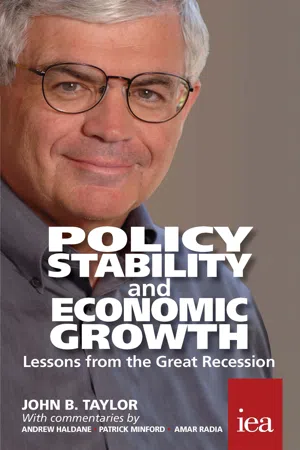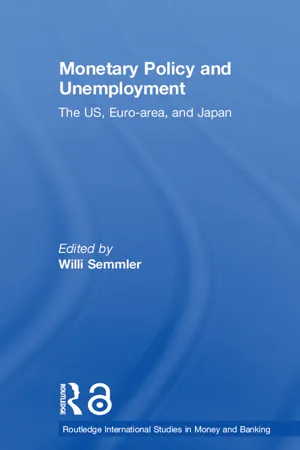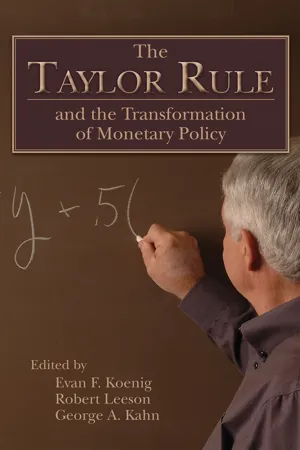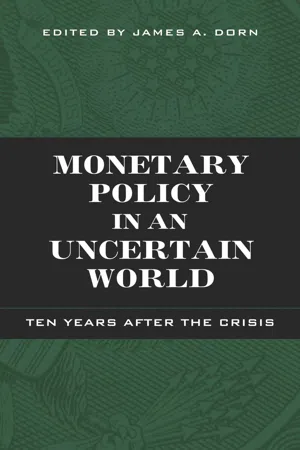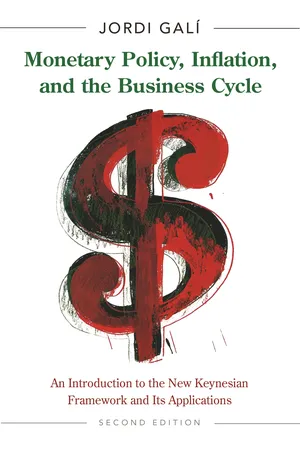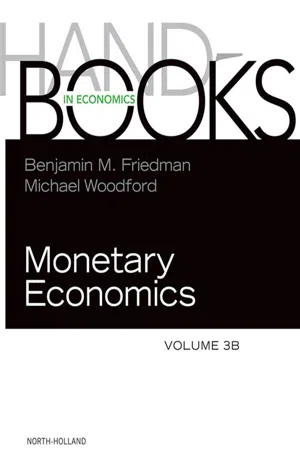Economics
Taylor Rule
The Taylor Rule is a monetary policy guideline developed by economist John Taylor. It suggests that central banks should adjust their interest rates in response to changes in inflation and output. The rule provides a systematic approach for policymakers to set interest rates based on economic conditions, aiming to achieve price stability and full employment.
Written by Perlego with AI-assistance
Related key terms
Related key terms
1 of 4
Related key terms
1 of 3
9 Key excerpts on "Taylor Rule"
- eBook - ePub
Policy Stability and Economic Growth
Lessons from the Great Recession
- John B. Taylor(Author)
- 2016(Publication Date)
- London Publishing Partnership(Publisher)
Secondly, in part due to their simplicity and transparency, Taylor Rules are more likely to deliver robustness in decision-making – for example, in the face of model uncertainty. A range of studies (Taylor 1999; Levin and Williams 2003) has demonstrated that a simple Taylor Rule is likely, on average, to deliver better performance across a range of models than either a complex rule or a fully optimal policy. In other words, a Taylor Rule can serve as a safeguard against model misspecification and uncertainty.The intuition behind this result is as follows. The optimal rule in any single model will exploit features of that model to generate better outcomes, so it is likely to be complex. But, in different model settings, these over-fitted complex rules may perform poorly. As the gains in moving from simple rules to optimal rules within any model are typically fairly modest, simple rules tend to be preferable across models. This carries the implication that Taylor Rules may be especially useful as policy guideposts at times of structural change.Thirdly, Taylor Rules have become essential modelling devices for policymakers. In most central bank models, the baseline path for monetary policy is generated by a Taylor-like rule. This closes the model, ensuring the price level is determinate. Moreover, because the Taylor Rule provides a reasonable fit of how policymakers have tended to behave over the past, it also captures the essence of how policy might be set in practice.Judgement remains centralWhile the past two decades have taught us a great deal about the usefulness of Taylor Rules, they have also highlighted some of their limitations. To explore those, consider the general form of the Taylor Rule:In Taylor’s original work, he set r * (the equilibrium rate of interest) to 2 per cent and (the weight on the difference between inflation and the target) and (the weight on the output gap) to 0.5. With an inflation target of 2 per cent, the canonical Taylor Rule is thusIn simple terms, this means that the interest rate should be set at 2 per cent, plus the rate of inflation, plus half the difference between actual inflation and the target rate of inflation (2 per cent), plus half the difference between actual output and trend output. If inflation was at target and output at potential, the prevailing real rate of interest would therefore be 2 per cent. - eBook - ePub
- Willi Semmler(Author)
- 2004(Publication Date)
- Routledge(Publisher)
4 It is therefore hard to draw a clear distinction between “rules” and “discretion” in this case. In the end, my analysis suggests that the unfavorable macroeconomic outcomes of the 1970s do not fundamentally reflect differences in the existing framework from Taylor’s rule-based framework. Rather, the analysis identifies misperceptions regarding the state of the economy in conjunction with an activist stabilization objective as the important factors leading to the inflationary experience of the 1970s.An overview of the Taylor Rule
The Taylor Rule originated in a collection of studies examining the comparative performance of alternative simple interest rate policy rules across a variety of different models (Bryant et al. 1993). A particularly promising rule in those studies prescribed that the Federal Reserve should set policy so that the deviation of the short-term nominal interest rate, R, from a baseline equilibrium value, R*, respond linearly to the deviation of inflation, π, from its desired target, π*, and to the output gap, y.Taylor (1993) proposed a particular parameterization of this rule that has attracted considerable attention. He set the sum of actual inflation and the equilibrium short-term real interest rate, r*, as a proxy for R*, and used the values r*=π*=2 and θ=1/2. (Throughout, the interest and inflation rates are stated in percent annual rates and the output gap in percent.) This parameterization attracted attention as a guide to policy decisions, because in addition to its encouraging performance in alternative models, as reported in Bryant et al. (1993), and several subsequent studies, it also appeared to accurately describe actual policy decisions in the 1987–92 period that Taylor had originally examined. Since, monetary policy over this period was considered successful, the confluence of the two results suggested that the Taylor Rule may represent a useful and reliable guide for monetary policy decisions. In recent years, prescriptions from a Taylor Rule have been regularly provided to Federal Open Market Committee (FOMC) members. Further, since January 1998 the Federal Reserve Bank of St Louis has published monthly updates of prescriptions from the Taylor Rule in the publication Monetary Trends - Robert Leeson, Evan F. Koenig, George A. Kahn(Authors)
- 2013(Publication Date)
- Hoover Institution Press(Publisher)
In the staff’s version of the Taylor Rule, the output and inflation gaps are lagged one period, the inflation target is 2.5 percent, the output gap is measured using a production function approach, the equilibrium real interest rate is derived from index-linked bonds, and the weight on the output gap is varied from 0.25 to 0.75. The staff analyzes and tries to explain differences between the Taylor Rule prescriptions and the Bank’s actual policy rates when they arise. In addition, the staff uses monetary policy rules “in both estimated and calibrated macroeconomic models to inform thinking about issues of monetary strategy” (Nikolov 2002, 8–10).IV.4. Other central banksOther inflation targeting central banks use Taylor Rules in a similar fashion to the Bank of England. At the Reserve Bank of Australia, “Consideration of the current stance of policy . . . is supplemented by . . . the output of a suite of Taylor Rule-type calculations . . . Staff research over the years has identified a couple of Taylor Rule formulations which we think are worth checking periodically” (Stevens 2001).In the model used for forecasting and policy analysis at the Reserve Bank of New Zealand (RBNZ)—the original inflation-targeting central bank—a specific reaction function characterizes the flexible inflation targeting regime. The policy rate is set equal to 1.4 times the sum of forecast deviations of inflation from target, six to eight quarters ahead (Black et al. 1997, as described in Huang et al. 2002, 6). Incidentally, the RBNZ claims to be the first central bank that “prepares and publishes economic projections based on endogenous interest rates—an approach we adopted in 1997” (Hampton 2002, 5).24The Swiss National Bank draws on a variety of models in developing the Bank’s inflation forecast. A Taylor Rule is incorporated in both its medium-sized and small-sized macro models. Other models in use at the Bank include a VAR model and an M3 model (Jordan and Peytrignet 2002).The use of Taylor Rules at central banks in emerging market economies is complicated by the prominent role played by exchange rates in monetary policy in most of these countries. This prominence is due to the high degree of pass-through of the exchange rate to domestic inflation, the desire to maintain competitiveness in the tradable goods sector, and concern for financial stability (Mohanty and Klau 2004, 1). Nevertheless, Taylor (2000) argues that “for those emerging market economies that do not choose a policy of a ‘permanently’ fixed exchange rate (perhaps through a currency board or a common currency [dollarization]), then the only sound policy is one based on the trinity of a flexible exchange rate, an inflation target, and a monetary policy rule- eBook - ePub
Monetary Policy in an Uncertain World
Ten Years After the Crisis
- James A. Dorn(Author)
- 2018(Publication Date)
- Cato Institute(Publisher)
1973 ). The research program in these papers involved comparative evaluations of active countercyclical monetary rules that were more elaborate than many of the simple Taylor-type rules that have been advocated more recently.5 The quote is from the conclusion of Taylor and Williams (2011 ).6 Indeed, such a process would heed the advice: “Prudence . . . suggests that the rule include procedures for its own amendment” (Fischer 1990 : 1169).Passage contains an image 15
NUDGING THE FED TOWARD A RULES- BASED POLICY REGIMEScott SumnerThere is a great deal of academic research suggesting that monetary policy should use a rules-based approach (e.g., Kydland and Prescott 1977 , McCallum 1985 , Plosser 2014 ). However, Fed officials have generally been opposed to any sort of rigid policy rule.There are two types of policy rules, both of which the Fed finds problematic. One involves a commitment to target a macroeconomic variable such as inflation, or nominal GDP, at a specified rate of growth. Today many central banks aim for approximately 2 percent inflation, although such rules are generally regarded as being flexible—with some weight also being given to output and/or employment stability. Even the European Central Bank, which has a simple inflation mandate, must also ensure that the eurozone monetary regime remains stable and viable.The Fed has a dual mandate for stable prices and high employment, which it interprets as 2 percent inflation and unemployment close to the natural rate. However, there is no clear indication of the weights assigned to each variable, and hence current policy cannot be viewed as a fully rules-based monetary regime. If both inflation and unemployment are above target, the Fed has discretion as to which problem deserves more attention.In other cases, the term “policy rule” refers to an instrument rule, such as the famous Taylor Rule, which would require that the Fed target the nominal fed funds rate (see Taylor 1993 - Michael D. Bordo, John B. Taylor, John H. Cochrane(Authors)
- 2023(Publication Date)
- Hoover Press(Publisher)
figure 4.1 . The other three rules considered by Bernanke, Kiley, and Roberts (2019b) are temporary price level targeting rules (TPLT) that are very similar to these seven rules but take into account the effective lower bound (ELB) of zero in the interest rate.Source: Bernanke, Kiley, and Roberts (2019b).FIGURE 4.1 .Policy Rules Studied by Bernanke, Kiley, and RobertsWhat explains this revival? One explanation is a revealed preference for such research on the part of monetary policy officials and others interested in monetary policy making. At the Chicago Fed conference, Cecchetti and Schoenholtz (2019) shared that they found, “The most frequently mentioned topic is the desirability of having a clear understanding of policy makers’ reaction function.” There were also statements by central bank leaders. Raghuram Rajan, former governor of the Reserve Bank of India, said, “What we need are monetary rules.” Mario Draghi, then president of the European Central Bank, said, “We would all clearly benefit from . . . improving communication over our reaction functions.” Jay Powell, chair of the Federal Reserve Board, said, “I find these rule prescriptions helpful.”Another explanation for the revival was the desire to figure out how to deal with the effective (or zero) lower bound on the interest rate. There was genuine concern about the lower bound in the case of a need for substantial easing. How else can one evaluate alternative proposals for “lower for longer” policy, such as the Reifschneider and Williams (2000) proposal, than with a rule? This is also a huge motivation behind the work by Lilley and Rogoff (2020).- eBook - ePub
- John Smithin(Author)
- 2008(Publication Date)
- Routledge(Publisher)
If, on the other hand, by a “low” interest rate we mean a low nominal rate, then the traditional criticisms of the classical economists against the monetary mercantilists from the eighteenth century, and repeated in all the successive debates, seem to be valid. In this case, there could be a problem with inflationary instability. 4 A version of the “Taylor Rule” The orthodox “Taylor Rule” for monetary policy, after Taylor (1993), suggested that the nominal policy rate (such as the federal funds rate in the USA) be raised “one for one” whenever the supposed (and actually unobservable) “natural rate” of interest increases, and whenever the actual inflation rate increases. It proposed further increases in the policy rate (that is more than one for one) if the observed inflation rate turns out to be greater than some arbitrary target, and/or if the current level of GDP is greater than the supposed “natural” or full-employment level of GDP. As the current inflation rate is explicitly regarded as a proxy for the expected inflation rate in this type of literature (ibid., 202), the rule could equivalently be expressed as changes in the real policy rate of interest. That is to raise the real policy rate if the observed inflation rate was greater than the preannounced target, or if real GDP was greater than its natural rate. In the subsequent literature, there was also some recognition that the term involving the GDP gap is really more or less redundant (Taylor 2000, 92). The reason for including such a term would be because the GDP gap is held to be a predictor of a future rise in inflation (as in the orthodox textbook macroeconomic model). However, even if such a rise does eventually come about, the desired response is already built in via the inflation gap term in the reaction function - eBook - ePub
Monetary Policy, Inflation, and the Business Cycle
An Introduction to the New Keynesian Framework and Its Applications - Second Edition
- Jordi Galí(Author)
- 2015(Publication Date)
- Princeton University Press(Publisher)
κ in the case of the forward-looking rule).The practical shortcomings of optimal interest rate rules discussed above have led many authors to propose a variety of “simple rules”—understood as rules that a central bank could arguably adopt in practice—and to analyze their properties.8 In that context, an interest rate rule is generally considered “simple” if it makes the policy instrument a function of observable variables only, and does not require any precise knowledge of the exact model or the values taken by its parameters. The desirability of any given simple rule is thus given to a large extent by its robustness, that is, its ability to yield a good performance across different models and parameter configurations.In the following section, two such simple rules are analyzed—a simple Taylor-type rule and a constant money growth rule—and their performance is assessed in the context of our baseline New Keynesian model.4.4T WO S IMPLE M ONETARY P OLICY R ULESThis section provides an illustration of how the basic New Keynesian model developed in chapter 3 can be used to assess the performance of two policy rules. A formal evaluation of the performance of a simple rule (relative, say, to the optimal rule or to an alternative simple rule) requires the use of some quantitative criterion. Following the seminal work of Rotemberg and Woodford (1999), much of the literature has adopted a welfare-based criterion, relying on a second-order approximation to the utility losses experienced by the representative consumer as a consequence of deviations from the efficient allocation. As shown in appendix 4.1 , under the assumptions made in this chapter (which guarantee the optimality of the flexible price equilibrium), that approximation yields the following welfare loss function - eBook - ePub
Rules for International Monetary Stability
Past, Present, and Future
- Michael D. Bordo, John B. Taylor(Authors)
- 2017(Publication Date)
- Hoover Institution Press(Publisher)
Chapter Six Rules-Based International Monetary Reform John B. Taylor, Richard Clarida, and George P. Shultz PART 1 An International Monetary System Built on Policy Rules and StrategiesJohn B. Taylor1For nearly two decades in the 1980s and 1990s, economic performance and stability improved in major parts of the world as monetary policy tended to be more focused and rules based. During much of the past decade, monetary policy has deviated from a rules-based approach in much of the world, and economic performance and stability has deteriorated, remaining poor today. As Paul Volcker (2014) has put it, “the absence of an official, rules-based, cooperatively managed monetary system has not been a great success.”In these remarks I discuss a new approach to international monetary policy. The proposed reform is based on years of experience and economic research which suggest that a rules-based reform in each country will deliver a rules-based international monetary system that “can better reconcile reasonably free and open markets with independent national policies [and] stability,” the sensible goal called for by Volcker (2014).I start with a review of the economic principles that indicate that such a rules-based policy will lead to good global economic performance. I then provide evidence—consistent with those principles—that shows that adhering to more rules-based policy has been associated with good performance while deviating from rules-based policy has been associated with poor economic performance. Building on this experience and the principles, I then describe the reform proposal and its implementation.The international monetary system: A rules-space or strategy-space approachEconomic research going back to the 1980s showed that simple rules-based monetary policy would result in good global economic performance (Carlozzi and Taylor 1985; Taylor 1985). In this research, the monetary policy of each central bank was viewed as a rule or strategy for the instruments of policy, and questions of international coordination or cooperation were addressed in “rules-space” or “strategy-space” rather than in terms of the setting for the policy instruments. If each central bank adopted a rules-based monetary policy that was optimal for its own country’s price and output stability, it would contribute to global stability. Moreover, there would be little additional gain from the central banks also jointly optimizing their policy rules or strategies. In other words, the research showed that the Nash equilibrium—where each country chose its monetary strategy taking as given other countries’ strategies—is nearly optimal, or nearly an internationally cooperative equilibrium. - eBook - ePub
- Benjamin M. Friedman, Michael Woodford(Authors)
- 2010(Publication Date)
- North Holland(Publisher)
Evaluating policy regimes: New research in empirical macroeconomics. Washington, D.C.: Brookings Institution; 1993:45–218.Judd J, Rudebusch GD. Taylor's rule and the Fed: 1970–1997. Economic Review. 1998;3:1–16 Federal Reserve Bank of San Francisco, San Francisco, CA.Kohn D. John Taylor Rules. In: Paper presented at a conference at the Federal Reserve Bank of Dallas, 2007; 2007.Kuester K, Wieland V. Insurance policies for monetary policy in the Euro area. J. Eur. Econ. Assoc. 2010;8(4):872–912.Kuttner KN. A snapshot of inflation targeting in its adolescence. In: Kent C, Guttmann S, eds. The future of inflation targeting. Sydney, Australia: Reserve Bank of Australia; 2004:6–42.Kydland FE, Prescott EC. Rules rather than discretion: The inconsistency of optimal plans. J. Polit. Econ. 1977;85(3):473–491.Laubach T, Williams JC. Measuring the natural rate of interest. Rev. Econ. Stat. 2003;85(4):1063–1070.Levin AT, Onatski A, Williams JC, Williams N. Monetary policy under uncertainty in micro-founded macroeconometric models. NBER Macroeconomics Annual. 2005;2005:229–289.Levin AT, Taylor JB. Falling behind the curve: A positive analysis of stop-start monetary policies and the great inflation. 2009 NBER Working Paper.Levin AT, Wieland V, Williams JC. Robustness of simple monetary policy rules under model uncertainty. In: Taylor JB, ed. Monetary policy rules. Chicago, IL: Chicago University Press; 1999:263–299.Levin AT, Wieland V, Williams JC. The performance of forecast-based monetary policy rules under model uncertainty. Am. Econ. Rev. 2003;93(3):622–645.Levin AT, Williams JC. Robust monetary policy with competing reference models. J. Monet. Econ. 2003;50:945–975.Lucas Jr. RE. Econometric policy evaluation: A critique. Carnegie Rochester Conference Series on Public Policy.
Index pages curate the most relevant extracts from our library of academic textbooks. They’ve been created using an in-house natural language model (NLM), each adding context and meaning to key research topics.
Explore more topic indexes
Explore more topic indexes
1 of 6
Explore more topic indexes
1 of 4
